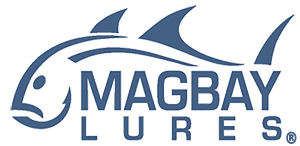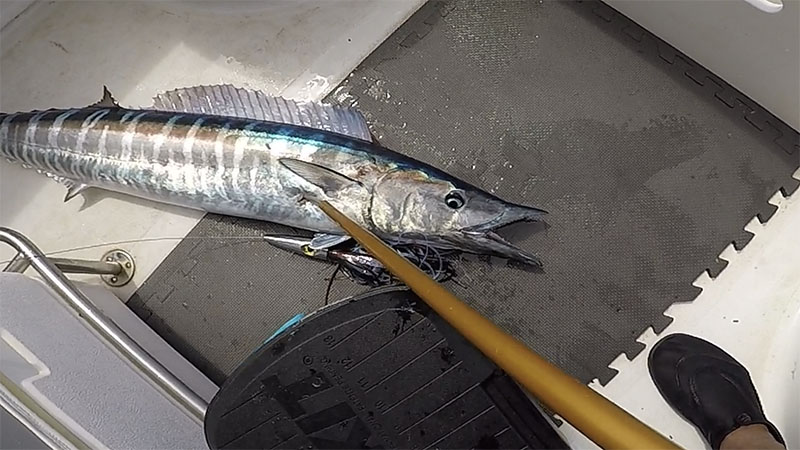Wahoo Trolling – What is the Best Speed?
Have you ever heard anyone say, “I am going to go do some high-speed tuna trolling”? Not so much, right? Or maybe “I like to troll for marlin at 16 knots”? Not really?
But why is this? Where did all this high-speed Wahoo stuff come from and why is it so important to understand?
Wahoo obviously are fast swimmers, they attack aggressively, and they are even shaped like a mini torpedo, but do they only eat at high speeds? Do you have to wind the wahoo bomb as fast as you can with the highest gear ratio available that only NASA engineers can explain how it goes so fast?
 It is my humble opinion that all of this high-speed talk is warranted, but also can be explored further. The cool thing is that Wahoo will strike at high speed and in fact they seem to like it. But, do they pass up lures cruising around at 9 knots and say “…nahhhh going too slow” – I don’t think so.
What I believe after hundreds of Wahoo caught personally and hundreds more watched, is that they hit the lure, bait, etc based on the timing as opposed to the speed.
What I mean by this, is that if the right color and right swimming lure goes by them when they are prepared to eat, they will. It does not matter how fast it goes by (within reason). I have found this by changing speeds same time of day, same location, same week in the Wahoo grounds and noted the results and analyzed the data.
What I have found is strikes appear to be fairly consistent for Wahoo (not that much greater at higher speeds, though I do see a slight advantage), but the slower speeds (6-9 knots) attract more fish like dorado, marlin, and tuna strikes.
Because the Wahoo strikes do in fact tend to have an advantage at the higher speed, I do not fully attribute it to the fact that they necessarily prefer higher speed, but rather that they are indifferent. The reality is at the higher speeds more water is passed by, so the lures run by more wahoo.
When it comes to casting bombs. Yes you have to wind fast, because below 6 or 7 knots the Wahoo simply do not tend to eat lures. But at 7 and above they will, even up to perhaps 20 knots as crazy as that sounds.
One small disclaimer here is that higher speeds do create more cavitation with certain lures, and obviously this also is an attractant that might get attention, where a slower speed might not.
In conclusion I have decided upon a few points for when high speed trolling is advisable and when it is not:
High Speed Trolling Recommended:
It is my humble opinion that all of this high-speed talk is warranted, but also can be explored further. The cool thing is that Wahoo will strike at high speed and in fact they seem to like it. But, do they pass up lures cruising around at 9 knots and say “…nahhhh going too slow” – I don’t think so.
What I believe after hundreds of Wahoo caught personally and hundreds more watched, is that they hit the lure, bait, etc based on the timing as opposed to the speed.
What I mean by this, is that if the right color and right swimming lure goes by them when they are prepared to eat, they will. It does not matter how fast it goes by (within reason). I have found this by changing speeds same time of day, same location, same week in the Wahoo grounds and noted the results and analyzed the data.
What I have found is strikes appear to be fairly consistent for Wahoo (not that much greater at higher speeds, though I do see a slight advantage), but the slower speeds (6-9 knots) attract more fish like dorado, marlin, and tuna strikes.
Because the Wahoo strikes do in fact tend to have an advantage at the higher speed, I do not fully attribute it to the fact that they necessarily prefer higher speed, but rather that they are indifferent. The reality is at the higher speeds more water is passed by, so the lures run by more wahoo.
When it comes to casting bombs. Yes you have to wind fast, because below 6 or 7 knots the Wahoo simply do not tend to eat lures. But at 7 and above they will, even up to perhaps 20 knots as crazy as that sounds.
One small disclaimer here is that higher speeds do create more cavitation with certain lures, and obviously this also is an attractant that might get attention, where a slower speed might not.
In conclusion I have decided upon a few points for when high speed trolling is advisable and when it is not:
High Speed Trolling Recommended:
 It is my humble opinion that all of this high-speed talk is warranted, but also can be explored further. The cool thing is that Wahoo will strike at high speed and in fact they seem to like it. But, do they pass up lures cruising around at 9 knots and say “…nahhhh going too slow” – I don’t think so.
What I believe after hundreds of Wahoo caught personally and hundreds more watched, is that they hit the lure, bait, etc based on the timing as opposed to the speed.
What I mean by this, is that if the right color and right swimming lure goes by them when they are prepared to eat, they will. It does not matter how fast it goes by (within reason). I have found this by changing speeds same time of day, same location, same week in the Wahoo grounds and noted the results and analyzed the data.
What I have found is strikes appear to be fairly consistent for Wahoo (not that much greater at higher speeds, though I do see a slight advantage), but the slower speeds (6-9 knots) attract more fish like dorado, marlin, and tuna strikes.
Because the Wahoo strikes do in fact tend to have an advantage at the higher speed, I do not fully attribute it to the fact that they necessarily prefer higher speed, but rather that they are indifferent. The reality is at the higher speeds more water is passed by, so the lures run by more wahoo.
When it comes to casting bombs. Yes you have to wind fast, because below 6 or 7 knots the Wahoo simply do not tend to eat lures. But at 7 and above they will, even up to perhaps 20 knots as crazy as that sounds.
One small disclaimer here is that higher speeds do create more cavitation with certain lures, and obviously this also is an attractant that might get attention, where a slower speed might not.
In conclusion I have decided upon a few points for when high speed trolling is advisable and when it is not:
High Speed Trolling Recommended:
It is my humble opinion that all of this high-speed talk is warranted, but also can be explored further. The cool thing is that Wahoo will strike at high speed and in fact they seem to like it. But, do they pass up lures cruising around at 9 knots and say “…nahhhh going too slow” – I don’t think so.
What I believe after hundreds of Wahoo caught personally and hundreds more watched, is that they hit the lure, bait, etc based on the timing as opposed to the speed.
What I mean by this, is that if the right color and right swimming lure goes by them when they are prepared to eat, they will. It does not matter how fast it goes by (within reason). I have found this by changing speeds same time of day, same location, same week in the Wahoo grounds and noted the results and analyzed the data.
What I have found is strikes appear to be fairly consistent for Wahoo (not that much greater at higher speeds, though I do see a slight advantage), but the slower speeds (6-9 knots) attract more fish like dorado, marlin, and tuna strikes.
Because the Wahoo strikes do in fact tend to have an advantage at the higher speed, I do not fully attribute it to the fact that they necessarily prefer higher speed, but rather that they are indifferent. The reality is at the higher speeds more water is passed by, so the lures run by more wahoo.
When it comes to casting bombs. Yes you have to wind fast, because below 6 or 7 knots the Wahoo simply do not tend to eat lures. But at 7 and above they will, even up to perhaps 20 knots as crazy as that sounds.
One small disclaimer here is that higher speeds do create more cavitation with certain lures, and obviously this also is an attractant that might get attention, where a slower speed might not.
In conclusion I have decided upon a few points for when high speed trolling is advisable and when it is not:
High Speed Trolling Recommended:
- Need to travel long distance: It is great to troll fast for Wahoo as you can cover more ground or get to where you are going faster. So this, in itself, is a huge advantage to high speed trolling because if you cover more ground (it means more chance of running by a fish) which in turn equates to more strikes.
- If you are not trying to get somewhere fast but all you care about are Wahoo, high speed trolling is recommended for the same reasons as point 1 above.
- Wahoo Tournaments: It is recommended to turn up the RPM’s to get that slight advantage
- Charter boat with clients on who just want to get fish and fish are abundant in a small area
- Those who enjoy lighter tackle fishing: Light gear is a big No No when trolling high speeds
- Wahoo is NOT the primary target species

